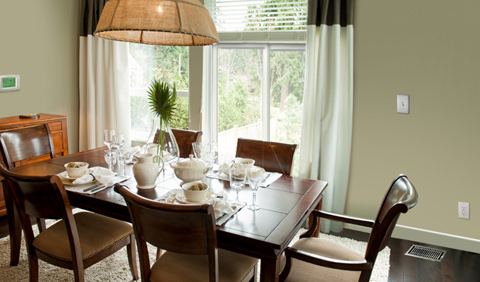Improve the quality of your home life and save on your utility bills by making your dining room more energy efficient.
Floor Vents/Radiators
- Ensure vent connections and registers are well sealed at floors, walls and ceilings, which are all common areas for disconnected ducts and leakage.
- Make sure all vents are clear of furniture and rugs, in order to improve airflow and comfort.
- Install heat resistant reflectors between radiators and walls to reflect heat back into the room instead of onto walls.
Sliding Door
- Apply caulking around doorframes and weather-stripping around doors that don’t close tightly.
- Protect interior furnishings, cut energy costs and improve comfort by replacing standard sliding doors with ENERGY STAR certified ones.
- Learn more:
- Lower your energy bill and experience increased comfort by improving your home’s “envelope”.
- A home sealing will reduce drafts and eliminate moisture problems caused by holes, cracks and gaps.
Light Fixture
- Replace standard light fixtures and bulbs with ENERGY STAR certified compact fluorescent light bulbs (CFLs) that provide a high quality light, use less energy and last up to 10 times longer than standard incandescent light bulbs.
- Learn more:
- Replace high energy consuming conventional chandeliers with energy efficient versions.
- ENERGY STAR certified lighting options are available at most home centers, lighting showrooms and specialty stores.
- ENERGY STAR certified light fixtures use 75% less energy, generate 75% less heat and last up to 10 times longer than standard lighting, while producing bright, warm light.
Programmable Thermostat
- A programmable thermostat will regulate your home’s temperature settings to adjust for when you’re away or sleeping.
- Learn more:
- A programmable thermostat with 4-temperature settings can save up to $180 a year in energy costs.
- Learn about cost-saving measures that maximize your energy savings with these Guidelines for Proper Use of Programmable Thermostats.
- Save money with a manual thermostat by turning it up during hot weather and lowering it during cold weather.
- COMMON MISCONCEPTION: it’s more energy efficient to keep a house cool all the time, rather than heating or cooling it according to need.
- Only heat or cool a house according to time of day and number of occupants.
- Total energy savings depend upon climate, usage patterns, and the efficiency of the home’s heating and cooling system.
- A programmable thermostat eliminates the need to manually adjust the temperature when leaving the house or going to bed, making it more comfortable and energy efficient.
Light Switch
- Always turn off the lights when leaving any room (or when it’s not in use).
Outlet
- A gasket is an effective and inexpensive way of sealing any holes and cracks around outlets.
- Unplug any battery chargers or power adapters when not in use.

